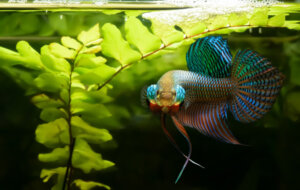Why Are Betta Fish Aggressive?


Written and verified by the biologist Cesar Paul Gonzalez Gonzalez
The betta fish (Betta splendens) is a fish in high demand in aquariums due to the fins and bright colors they boast. In addition, these fish are easy to keep in home tanks, so they’re highly recommended for those who are new to aquarium keeping. However, not everything is perfect: betta fish are often aggressive, which is a problematic trait of the species.
Although it may not seem like it, behavior is an adaptive characteristic in animals, and so there’s a reason behind the hostility of this species. Read on to find out why betta fish are aggressive.
What does a free-living betta fish look like?
The betta’s body reaches a size of approximately 6 centimeters (2.2 inches) in length and carries fairly large caudal, anal and pelvic fins. The natural coloration of these fish shows a green-brown fusion with bright dots and stripes. Also, sexual dimorphism is evident: males are more resplendent, while females exhibit larger sizes.
The scientific name of this species is Betta splendens and it’s a member of the Osphronemidae family which is able to live in oxygen-poor waters. To achieve this, it developed a special organ known as a labyrinth, which allows it to take in aerial oxygen. When the water quality is poor, bettas gasp at the surface and breathe.
Thanks to this, bettas can survive in poor water bodies with excess vegetation and organic matter.

What is the point of being aggressive?
Aggressive behavior has an important role in nature, as it does more than just protect the integrity of the species. This mechanism also makes it possible to obtain a mate, maintain social status, or defend the offspring from danger. Seen in another way, hostility enables it to be successful in its environment.
In the eyes of natural selection, an animal is successful when it’s able to survive and exploit all the resources of its environment. So, it isn’t only the ability to stay alive that counts, but also the ability to obtain food, find a mate, and protect its offspring.
Thanks to aggressiveness, the fittest organisms are selected and have greater benefits to meet their needs. This also means that the “best genes” are passed on to the next generations, which favors the evolutionary process of the species in general.
The aggressive behavior of betta fish
This species is usually social when it lives with other fish in the aquarium and only shows aggressive behavior towards fellow members of its species. This situation is evident when two specimens of the same gender meet, but the behavior is more pronounced in males than in females.
When one male betta meets another, both begin a kind of ritual in an attempt to threaten their competitor. To begin with, the specimens show the length of their fins, extending them in all their splendor as a sign of superiority. This is done to show who is bigger, and to frighten the rival.
If this doesn’t work and both maintain their intentions to fight, they continue with the display of their gills, which increases their threatening appearance. When neither of them gives up, the males proceed to fight each other with the aim of killing their opponent (in the worst case scenario). In the end, the individual that retreats or dies in the process loses the battle.
Why are betta fish aggressive?
Betta fish are aggressive because they compete for social rank in their natural environment, which allows them to hoard food and have access to females. Although it sounds strange, this is very important for the species, since without these resources the specimens would be unable to reproduce and leave offspring.
These fish have the ability to remember the ranks and to detect the dominant specimens with the naked eye. This recognition capability helps them to prevent conflicts from escalating into fights. A physical fight between the fish leads to more losses than gains, as injuries can be serious for both.
In fact, just keeping the fins outstretched takes a lot of energy, making battles even more costly for the males. Because of this, betta fish tend to bully only a little, in order to avoid a fight at all costs.
In an aquarium there is so little space, that a conflict will almost certainly end in a fatality.

As you can see, aggressive behavior represents a trait that benefits species adaptation. Although it may not seem like it, animal behavior is just another evolutionary tool (and not just random, meaningless attitudes). This idea coincides with what the geneticist Dobzhansky stated in 1973: “nothing makes sense in biology, if not seen in the light of evolution“.
The betta fish (Betta splendens) is a fish in high demand in aquariums due to the fins and bright colors they boast. In addition, these fish are easy to keep in home tanks, so they’re highly recommended for those who are new to aquarium keeping. However, not everything is perfect: betta fish are often aggressive, which is a problematic trait of the species.
Although it may not seem like it, behavior is an adaptive characteristic in animals, and so there’s a reason behind the hostility of this species. Read on to find out why betta fish are aggressive.
What does a free-living betta fish look like?
The betta’s body reaches a size of approximately 6 centimeters (2.2 inches) in length and carries fairly large caudal, anal and pelvic fins. The natural coloration of these fish shows a green-brown fusion with bright dots and stripes. Also, sexual dimorphism is evident: males are more resplendent, while females exhibit larger sizes.
The scientific name of this species is Betta splendens and it’s a member of the Osphronemidae family which is able to live in oxygen-poor waters. To achieve this, it developed a special organ known as a labyrinth, which allows it to take in aerial oxygen. When the water quality is poor, bettas gasp at the surface and breathe.
Thanks to this, bettas can survive in poor water bodies with excess vegetation and organic matter.

What is the point of being aggressive?
Aggressive behavior has an important role in nature, as it does more than just protect the integrity of the species. This mechanism also makes it possible to obtain a mate, maintain social status, or defend the offspring from danger. Seen in another way, hostility enables it to be successful in its environment.
In the eyes of natural selection, an animal is successful when it’s able to survive and exploit all the resources of its environment. So, it isn’t only the ability to stay alive that counts, but also the ability to obtain food, find a mate, and protect its offspring.
Thanks to aggressiveness, the fittest organisms are selected and have greater benefits to meet their needs. This also means that the “best genes” are passed on to the next generations, which favors the evolutionary process of the species in general.
The aggressive behavior of betta fish
This species is usually social when it lives with other fish in the aquarium and only shows aggressive behavior towards fellow members of its species. This situation is evident when two specimens of the same gender meet, but the behavior is more pronounced in males than in females.
When one male betta meets another, both begin a kind of ritual in an attempt to threaten their competitor. To begin with, the specimens show the length of their fins, extending them in all their splendor as a sign of superiority. This is done to show who is bigger, and to frighten the rival.
If this doesn’t work and both maintain their intentions to fight, they continue with the display of their gills, which increases their threatening appearance. When neither of them gives up, the males proceed to fight each other with the aim of killing their opponent (in the worst case scenario). In the end, the individual that retreats or dies in the process loses the battle.
Why are betta fish aggressive?
Betta fish are aggressive because they compete for social rank in their natural environment, which allows them to hoard food and have access to females. Although it sounds strange, this is very important for the species, since without these resources the specimens would be unable to reproduce and leave offspring.
These fish have the ability to remember the ranks and to detect the dominant specimens with the naked eye. This recognition capability helps them to prevent conflicts from escalating into fights. A physical fight between the fish leads to more losses than gains, as injuries can be serious for both.
In fact, just keeping the fins outstretched takes a lot of energy, making battles even more costly for the males. Because of this, betta fish tend to bully only a little, in order to avoid a fight at all costs.
In an aquarium there is so little space, that a conflict will almost certainly end in a fatality.

As you can see, aggressive behavior represents a trait that benefits species adaptation. Although it may not seem like it, animal behavior is just another evolutionary tool (and not just random, meaningless attitudes). This idea coincides with what the geneticist Dobzhansky stated in 1973: “nothing makes sense in biology, if not seen in the light of evolution“.
All cited sources were thoroughly reviewed by our team to ensure their quality, reliability, currency, and validity. The bibliography of this article was considered reliable and of academic or scientific accuracy.
- Collias, N. E. (1944). Aggressive behavior among vertebrate animals. Physiological Zoology, 17(1), 83-123.
- Pleeging, C. C. F., & Moons, C. (2017). Potential welfare issues of the Siamese fighting fish (Betta splendens) at the retailer and in the hobbyist aquarium. Vlaams Diergeneeskundig Tijdschrift, 86(4), 213-223.
- Polgardani, N. Z., Rouzbehani, S., & Parsaiyan, M. (2017). Male Siamese fighting fish (Betta splendens) recognize resource holding power of opponents. Aquaculture, Aquarium, Conservation & Legislation, 10(4), 977-982.
- Lynn, S. E., Egar, J. M., Walker, B. G., Sperry, T. S., & Ramenofsky, M. (2007). Fish on Prozac: a simple, noninvasive physiology laboratory investigating the mechanisms of aggressive behavior in Betta splendens. Advances in Physiology Education, 31(4), 358-363.
- Braddock, J. C., & Braddock, Z. I. (1955). Aggressive behavior among females of the Siamese fighting fish, Betta splendens. Physiological Zoology, 28(2), 152-172.
- Castro, N., Ros, A. F., Becker, K., & Oliveira, R. F. (2006). Metabolic costs of aggressive behaviour in the Siamese fighting fish, Betta splendens. Aggressive Behavior: Official Journal of the International Society for Research on Aggression, 32(5), 474-480.
This text is provided for informational purposes only and does not replace consultation with a professional. If in doubt, consult your specialist.








